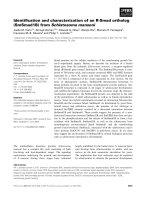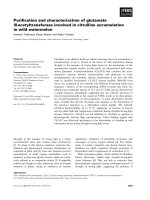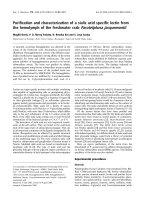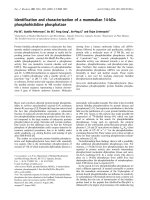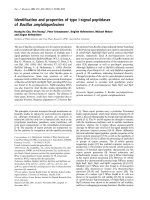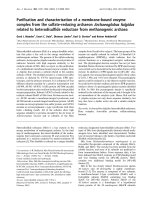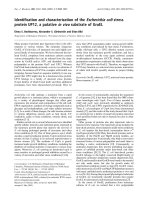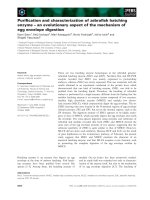Báo cáo khoa học: Identification and localization of glycine in the inner core lipopolysaccharide of Neisseria meningitidis ppt
Bạn đang xem bản rút gọn của tài liệu. Xem và tải ngay bản đầy đủ của tài liệu tại đây (514.95 KB, 7 trang )
Identification and localization of glycine in the inner core
lipopolysaccharide of
Neisseria meningitidis
Andrew D. Cox, Jianjun Li and James C. Richards
Institute for Biological Sciences, National Research Council, Ottawa, ON, Canada
The amino acid glycine is identified as a component of the
inner core oligosaccharide in meningococcal lipopolysac-
charide (LPS). Ester-linked glycine residues were consis-
tently found by mass spectrometry experiments to be located
on the distal heptose residue (HepII) in LPS from several
strains of Neisseria meningitidis. Nuclear magnetic resonance
studies confirmed and extended this observation locating the
glycine residue at the 7-position of the HepII molecule in L3
and L4 immunotype strains.
Keywords: Neisseria meningitidis; lipopolysaccharide;
glycine; NMR; mass spectrometry.
The LPS of Neisseria meningitidis contains a core
oligosaccharide unit with an inner core di-heptose-N-
acetyl-glucosamine backbone, wherein the two
L
-glycero-
D
-manno-heptose (Hep) residues can provide a point of
attachment for the outer core oligosaccharide residues [1].
Meningococcal LPS has been classified into 12 distinct LPS
immunotypes (L1-L12), originally defined by monoclonal
antibody (mAb) reactivities [2], but further defined by
structural analyses. The structures of LPS from immuno-
types L1/6 [3,4], L2 [5], L3 [6], L4/7 [7], L5 [8] and L9 [9]
have been elucidated. The structural basis of the immuno-
typing scheme is governed by the location of a phospho-
ethanolamine (PEtn) moiety on the distal heptose residue
(HepII) at either the 3- or 6-position or absent. The length
and nature of oligosaccharide extension from the proximal
heptose residue (HepI) and the presence or absence of a
glucose sugar at HepII also dictates the immunotype. The
enzyme UDP glucose-4-epimerase (GalE) is essential for
N. meningitidis to synthesize UDP-Gal for incorporation of
galactose into its LPS and is encoded by the gene galE [10].
The absence of galactose residues in the conserved inner
core structure of meningococcal LPS has led to the
utilization of mutants defective in the enzyme, resulting in
the truncation of the LPS’s oligosaccharide chain at the
glucose residue at HepI, and galE mutants have been used
by our group in order to derive mAbs to inner core LPS
epitopes [11]. mAb B5 was identified in this way, which had
an absolute requirement for PEtn at the 3-position of
HepII. Subsequently this mAb was used to identify the gene
lpt3 that is responsible for the transfer of the PEtn residue to
the 3-position of HepII [12]. During the course of these
studies we examined the core oligosaccharide of a clinical
isolate NGH15, which revealed additional O-linked residues
that had not previously been identified in meningococcal
LPS. In earlier studies, for ease of interpretation of
otherwise complex data, the majority of structural analyses
on meningococcal core oligosaccharides had been per-
formed following O-deacylation and/or dephosphorylation.
Naturally, base-labile residues that may have been present
in the native LPS molecule would have been removed by
such procedures. Previous studies had identified O-acetyl
groups in the core oligosaccharide of some immunotype
strains [3,5,7,8]. In this study we identify and structurally
characterize the presence of ester-linked glycine residues in
the core oligosaccharide of meningococcal LPS.
MATERIALS AND METHODS
Growth of organism and isolation of LPS
N. meningitidis immunotype strains L3 galE (NRCC #4720)
and L4 galE (NRCC #4719) and clinical strains BZ157 galE
B5+ (NRCC #6094) and NGH15 B5+ and B5– (NRCC
#6092 and 6093) were all grown in a 28-L fermenter as
described previously [11] yielding 100 g wet wt. of cells
from each growth. Strains BZ157 and NGH15 are from the
culture collection of E. R. Moxon. LPS was extracted by
the hot phenol/water method as described previously and
purified from the aqueous phase by ultracentrifugation
(45K, 4 °C, 5 h) [11] yielding 200 mg in each case.
O-deacylated LPS was prepared as described previously [13]
in 50% yield from the LPS. Core oligosaccharides were
prepared according to the following procedure. LPS was
hydrolysed at 100 °C for 2 h in 2% acetic acid. Insoluble
material was removed by centrifugation (6000 g, 20 min.)
and the supernatant solution was lyophilized yielding core
oligosaccharide in 50% yield.
Mass spectrometry
All ES-MS and CE-MS analyses were carried out as
described previously [12].
NMR spectroscopy
Nuclear magnetic resonance experiments were performed
on Varian INOVA 500, 400 and 200 NMR spectrometers as
Correspondence to A. D. Cox, Institute for Biological Sciences,
National Research Council, 100, Sussex Drive, Ottawa, ON K1A 0R6,
Canada. Fax: + 1 613 952 9092, Tel.: + 1 613 991 6172,
E-mail:
Abbreviation: LPS, lipopolysaccharide.
(Received 15 April 2002, revised 25 June 2002, accepted 24 July 2002)
Eur. J. Biochem. 269, 4169–4175 (2002) Ó FEBS 2002 doi:10.1046/j.1432-1033.2002.03131.x
described previously [14]. The 2D
13
C-
1
HHMBCexperi-
ment was acquired on a Varian Inova 500 spectrometer and
was of the order of 15 h. The
13
C–
1
H coupling constant was
140 Hz, with a sweep width in the F2 (
1
H) dimension of
10.0 p.p.m. and in the F1 (
13
C) dimension of 230 p.p.m.
Water presaturation during the relaxation delay was 1.0 s,
acquisition time in t
2
was 0.205 s, and 80 increments with
256 scans per increment were obtained.
RESULTS
Mild acid hydrolysis of immunotype L3 galE and L4 galE
LPS afforded core oligosaccharides that were initially
examined by ES-MS (Fig. 1). Several ions were observed
and the compositions for each glycoform are listed in
Table 1. Typical ions differing by 18 a.m.u. were observed
for each glycoform and corresponded to reducing end
anhydro and intact Kdo species due to rearrangements of
the Kdo molecule during hydrolysis. L3 galE core oligo-
saccharide consisted of two sets of ions differing by 57
a.m.u. (Fig. 1A). The ion at m/z 1110 corresponds to a
composition of Hex, 2Hep, HexNAc, PEtn, Kdo as would
be expected for the galE mutant, as further extension
beyond the first glucose (GlcI) at the proximal heptose
residue (HepI) is precluded due to the unavailability of
galactose in this genetic background. A second ion, 57
a.m.u. higher, of approximately equal intensity was
observed at m/z 1167. A mass of 57 a.m.u. corresponds to
the amino acid glycine (Gly) that has been reported
previously in the LPS of several Gram-negative bacteria
[15] but not in N. meningitidis.TheES-MSofL4galE core
oligosaccharide reflected a more complex mixture (Fig. 1B).
In addition to glycoforms corresponding to the presence or
absence of glycine, species with and without an O-acetyl
group and the PEtn residue were also observed (Table 1).
As indicated in Table 1 for L4 galE core oligosaccharide,
the ions at m/z 969 and 987 correspond to the expected core
oligosaccharides without the PEtn moiety. Ions at m/z 1011
and 1029 correspond to the same core oligosaccharides but
with an additional O-acetyl group. Ions at m/z 1092 and
1110 correspond to the expected inner core structure
without any modifications corresponding to a composition
of Hex, 2Hep, HexNAc, PEtn, Kdo. The final two sets of
ions correspond to the addition of an O-acetyl group alone
(m/z 1134,1152) and both an O-acetyl group and a glycine
moiety (m/z 1191, 1209) to the expected inner core structure.
To locate the glycine residue in the inner core oligosaccha-
ride of L3 galE, MS-MS studies were performed in positive
ion mode, as the positive functionalities available on the
glycine and ethanolamine moieties enable more stable
Fig. 1. Transformed electrospray mass spec-
trum of N. meningitidis strains (A) L3 galE
core oligosaccharide (B) L4 galE core oligo-
saccharide obtained in negative ion mode.
4170 A. D. Cox et al. (Eur. J. Biochem. 269) Ó FEBS 2002
fragment ions to be formed (Fig. 2). Fragmentation of the
positively charged ion at m/z 1169 of L3 galE oligosaccha-
ride (Fig. 2A) produced a series of ions due to consecutive
losses of glycose residues as indicated. A product ion at m/z
373 was diagnostic for the location of the glycine residue at
the distal heptose residue (HepII), as this ion corresponds to
Gly-HepII-PEtn.Inthesamewaytheglycinemoietywas
localized in the L4 galE core oligosaccharide, wherein
fragmentation of the positively charged ion at m/z 1193 gave
a similar series of ions (Fig. 2B) to those observed for L3
galE core oligosaccharide. In addition to a similar location
for the glycine residue being identified, the O-acetyl group of
the L4 galE oligosaccharide was also localized in this
experiment by virtue of an ion at m/z 246 that corresponds
to the N-acetyl-glucosamine residue bearing an O-acetyl
group. This ion can be compared to the ion at m/z 204 in the
fragmentation of L3 galE oligosaccharide (Fig. 2A) that
does not contain an O-acetyl group. ES-MS analyses were
Table 1. Negative ion ES-MS data and proposed compositions of core oligosaccharide from N. meningitidis strains. L3 galE,L4galE,NGH15B5
–
and B5
+
and BZ157 galE B5
+
. Average mass units were used for calculation of molecular mass based on proposed composition as follows: Glc,
162.15; Hep, 192.17; GlcNAc, 203.19; Kdo, 220.18; PEtn, 123.05. Gly, 57.05; OAc, 42.00.
Strain
Observed Ions (m/z) Molecular Mass (Da)
Relative
intensity
Proposed composition
(M-H)
–
(M-2H)
2–
Observed Calculated
L3 galE 1091.4 – 1092.3 1092.9 0.3 Glc, GlcNAc, 2Hep, PEtn, aKdo
1109.3 554.2 1110.5 1110.9 1.0 Glc, GlcNAc, 2Hep, PEtn, Kdo
1148.5 – 1149.5 1149.9 0.5 Gly, Glc, GlcNAc, 2Hep, PEtn, aKdo
1166.4 582.5 1167.4 1167.9 0.9 Gly, Glc, GlcNAc, 2Hep, PEtn, Kdo
L3 galE O-deac 1091.5 – 1092.6 1092.9 0.2 Glc, GlcNAc, 2Hep, PEtn, aKdo
1109.4 554.2 1110.5 1110.9 1.0 Glc, GlcNAc, 2Hep, PEtn, Kdo
L4 galE 968.3 – 969.3 969.8 0.2 Glc, GlcNAc, 2Hep, aKdo
986.4 – 987.3 987.8 0.2 Glc, GlcNAc, 2Hep, Kdo
1010.2 – 1011.4 1011.8 0.4 OAc, Glc, GlcNAc, 2Hep, aKdo
1028.1 – 1029.1 1029.8 0.6 OAc, Glc, GlcNAc, 2Hep, Kdo
1091.5 – 1092.4 1092.9 0.3 Glc, GlcNAc, 2Hep, PEtn, aKdo
1109.3 – 1110.4 1110.9 0.3 Glc, GlcNAc, 2Hep, PEtn, Kdo
1133.4 – 1134.3 1134.9 0.8 OAc, Glc, GlcNAc, 2Hep, PEtn, aKdo
1151.4 – 1152.3 1152.9 0.9 OAc, Glc, GlcNAc, 2Hep, PEtn, Kdo
1190.3 – 1191.4 1191.9 1.0 Gly, OAc, Glc, GlcNAc, 2Hep, PEtn, aKdo
1208.3 – 1209.3 1209.9 0.5 Gly, OAc, Glc, GlcNAc, 2Hep, PEtn, Kdo
NGH15 B5- – 747.6 1496.9 1497.3 0.5 3Hex, 2HexNAc, 2Hep, aKdo
– 756.4 1514.9 1515.3 0.4 3Hex, 2HexNAc, 2Hep, Kdo
– 768.7 1539.3 1539.3 0.4 OAc, 3Hex, 2HexNAc, 2Hep, aKdo
– 777.6 1557.5 1557.3 1.0 OAc, 3Hex, 2HexNAc, 2Hep, Kdo
– 796.8 1595.9 1596.3 0.3 Gly, OAc, 3Hex, 2HexNAc, 2Hep, aKdo
– 806.0 1614.4 1614.3 0.4 Gly, OAc, 3Hex, 2HexNAc, 2Hep, Kdo
NGH15 B5+ – 808.9 1620.0 1620.3 0.1 3Hex, 2HexNAc, 2Hep, PEtn, aKdo
– 818.0 1638.0 1638.3 0.3 3Hex, 2HexNAc, 2Hep, PEtn, Kdo
– 830.0 1662.6 1662.3 0.3 OAc, 3Hex, 2HexNAc, 2Hep, PEtn, aKdo
– 837.5 1677.0 1677.3 0.1 Gly, 3Hex, 2HexNAc, 2Hep, PEtn, aKdo
1678.8 839.0 1680.1 1680.3 1.0 OAc, 3Hex, 2HexNAc, 2Hep, PEtn, Kdo
– 846.5 1694.9 1695.3 0.1 Gly, 3Hex, 2HexNAc, 2Hep, PEtn, Kdo
– 858.5 1718.9 1719.3 0.3 Gly, OAc, 3Hex, 2HexNAc, 2Hep, PEtn, aKdo
– 867.5 1737.0 1737.3 0.4 Gly, OAc, 3Hex, 2HexNAc, 2Hep, PEtn, Kdo
BZ157 galE B5+ 1011.3 – 1011.7 1011.8 0.1 OAc, Glc, GlcNAc, 2Hep, aKdo
1028.4 – 1029.4 1029.8 0.2 OAc, Glc, GlcNAc, 2Hep, Kdo
– 545.2 1092.6 1092.9 0.2 Glc, GlcNAc, 2Hep, PEtn, aKdo
– 554.1 1110.3 1110.9 0.2 Glc, GlcNAc, 2Hep, PEtn, Kdo
1133.5 566.3 1134.5 1134.9 0.7 OAc, Glc, GlcNAc, 2Hep, PEtn, aKdo
1151.5 575.4 1152.7 1152.9 1.0 OAc, Glc, GlcNAc, 2Hep, PEtn, Kdo
1190.4 594.7 1191.4 1191.9 0.4 Gly, OAc, Glc, GlcNAc, 2Hep, PEtn, aKdo
1208.7 – 1209.8 1209.9 0.3 Gly, OAc, Glc, GlcNAc, 2Hep, PEtn, Kdo
1256.6 628.0 1257.7 1257.9 0.6 OAc, Glc, GlcNAc, 2Hep, 2PEtn, aKdo
1274.7 636.9 1275.8 1275.9 0.6 OAc, Glc, GlcNAc, 2Hep, 2PEtn, Kdo
1313.6 – 1314.6 1314.9 0.6 Gly, OAc, Glc, GlcNAc, 2Hep, 2PEtn, aKdo
1331.5 – 1332.6 1332.9 0.3 Gly, OAc, Glc, GlcNAc, 2Hep, 2PEtn, Kdo
Ó FEBS 2002 Glycine in meningococcal LPS (Eur. J. Biochem. 269) 4171
also performed on two other meningococcal strains of
clinical origin and the compositions of the glycoforms
observed are listed in Table 1. In each case where glycine
was identified, MS-MS studies located this residue to the
HepII molecule (data not shown).
The glycine residue was assumed to be ester-linked
because it had not been observed in O-deacylated material
examined from these samples [6,7]. Base-labile ester-linked
residues are readily removed under the alkaline conditions
for O-deacylation. To confirm this, O-deacylated LPS
from L3 galE was hydrolysed with 2% acetic acid in
order to afford the O-deacylated core oligosaccharide.
ES-MS analysis for this sample revealed a simplified
spectrum without ions corresponding to glycine con-
taining glycoforms (Table 1), thus confirming that the
glycine residue is attached to the core oligosaccharide via
an ester linkage.
In order to confirm and further characterize the presence
of the glycine residue, NMR studies were performed. Initial
experiments on commercial glycine suggested the
1
Hand
13
C resonances of the -CH
2
- group were at 3.56 and
41.5 p.p.m., respectively. The core oligosaccharide from L3
galE was chosen for NMR studies as the MS data had
indicated a less complex mixture than the core oligosaccha-
ride from L4 galE.A
13
C-
1
H HSQC experiment (Fig. 3A)
revealed a cross-peak with a
1
H resonance of 3.56 p.p.m.
and a
13
C resonance of 42.4 p.p.m., in excellent agreement
with the glycine standard. A
13
C-
1
HHMBCexperiment
(Fig. 3B) produced a cross-peak at
1
H resonance at
3.56 p.p.m. and a
13
C resonance at 172.5 p.p.m. consistent
Fig. 2. Positive ion capillary electrophoresis-
electrospray mass spectrum of O-deacylated
LPS from N. meningitidis strains (A) L3 galE
core oligosaccharide MS/MS of m/z 1169; (B)
L4 galE core oligosaccharide MS/MS of m/z
1193. Fragmentation pathways of the core
oligosaccharides are illustrated by indication
of the molecules lost from the core oligosac-
charide to give the resulting fragment ions.
Diagnostic ions that localized the glycine
residue and the O-acetylation status of the
GlcNAc residue are indicated in the inset
figures.
4172 A. D. Cox et al. (Eur. J. Biochem. 269) Ó FEBS 2002
with relay between the carbonyl carbon and the CH
2
protons of the glycine moiety, thus confirming the identi-
fication of glycine.
NMR provided evidence for the exact location of the
glycine moiety on the HepII residue of the inner core
oligosaccharide. There are only a few positions available for
attachment on this substituted residue in the meningococcal
LPS inner core. Linkage to HepI occurs from the anomeric
position of HepII, the N-acetyl-glucosamine residue substi-
tutes HepII at the 2-position and PEtn substitutes HepII at
the 3-position in immunotype L3 and at the 6-position in
immunotype L4. Ring formation occurs at position 5 in this
pyranose sugar. There are therefore only two locations
available for the glycine moiety namely the 4-position or the
7-position of the HepII residue common to both immuno-
types. If the glycine residue was linked to the 4-position of
HepII one might expect the CH
2
protons of the glycine
molecule to be split by the plane of symmetry from the
carbohydrate ring. However, as the CH
2
protons appear as
a sharp singlet at 3.56 p.p.m. in the
1
H spectrum, this would
suggest that they are behaving as equivalent protons and
have not been affected by the pyranose ring. This behaviour
is more consistent with an exocyclic location, where the
additional freedom would enable these protons to appear
equivalent. Additional evidence that the 4-position is not the
location of the glycine moiety was obtained when the
chemical shifts of the
1
H resonances of the HepII molecule
were compared for the core oligosaccharide and O-deacy-
lated core oligosaccharide from L3 galE (Table 2). Clearly
if O-deacylation removed the glycine group from the
4-position one would expect a change in the chemical shift
of the H-4
1
H resonance between the O-deacylated and
native core oligosaccharide. This is not the case as
1
H
resonances for each spin-system from H-1 to H-5 are
virtually identical and therefore provides further evidence
that the glycine residue is located at an exocyclic position,
presumably the 7-position of the HepII residue.
To confirm the location of the glycine moiety at the HepII
residue,
31
P-
1
HHMQCand
31
P-
1
H HMQC-TOCSY
experiments (Fig. 4) were performed on O-deacylated L4
galE oligosaccharide. Oligosaccharide derived from the L4
immunotype LPS was chosen for this analysis because of
the inherent difficulties in accessing the exocyclic protons in
a heptosyl spin-system from the anomeric proton resonance.
The HepII residue of immunotype L4 LPS is substituted at
the 6-position by a PEtn residue and therefore this
configuration was taken advantage of in
31
P-
1
HNMR
experiments [7]. The
31
P-
1
H HMQC experiment revealed
cross-peaks from the
31
P-resonance of the PEtn molecule at
the 6-position of HepII to
1
H-resonances at 4.58 p.p.m.
which is characteristic for substitution of the 6-position of
Fig. 3. Regions of the (A) 2D-
13
C-
1
H-HSQC
NMR and (B) 2D-
13
C-
1
H-HMBC NMR
spectra of the core oligosaccharide from
N. meningitidis strain L3 galE illustrating the
-CH
2
- group of the glycine residue and the
-CH
2
-CO
2
- connectivity within the glycine
residue, respectively.
Table 2.
1
H NMR assignment of HepII residue from N. meningitidis L3
galE core oligosaccharide. The spectrum was recorded at 25 °Crelative
to HOD at 4.77 p.p.m.
Sugar Residue H1 H2 H3 H4 H5
HepII 5.52 4.37 4.40 4.13 3.70
HepII
a
5.51 4.37 4.40 4.13 3.70
a
Data for the O-deacylated core oligosaccharide.
Fig. 4. Region of the 2D-
31
P-
1
H-HMQC-TOCSY
NMR spectrum of the core oligosaccharide from
N. meningitidis strain L4 galE.
Ó FEBS 2002 Glycine in meningococcal LPS (Eur. J. Biochem. 269) 4173
HepII with PEtn and resonances at 3.32 and 4.18 p.p.m.
diagnostic for the ethanolamine protons distal and proximal
to the phosphorus atom, respectively [7]. The
31
P-
1
H
HMQC-TOCSY experiment revealed additional cross
peaks at 3.85 and 3.75 p.p.m. consistent with nonsubstituted
H-7
1
H-resonances [7]. When these experiments were
performed on L4 galE oligosaccharide the
31
P-
1
H cross-
peaks observed were identical, apart from an addi-
tional
1
H-resonance at 4.38 p.p.m. consistent with the
presence of a substituent at the 7-position of HepII. Signals
indicative of the presence and absence of substituents at the
7-position of HepII in the L4 galE oligosaccharide, are
consistent with the nonstoichiometric substitution of glycine
as indicated by ES-MS experiments. This data therefore
confirmed that the glycine residue was attached at the
7-position of the HepII molecule in L4 galE oligosaccharide.
The similarity of the NMR data for the glycine residue in L3
galE oligosaccharide and BZ157 B5+ galE oligosaccharide,
and MS data for other strains that elaborate glycine would
suggest that in meningococcal LPS the glycine moiety is
consistently located at the 7-position of the HepII residue.
DISCUSSION
This paper has described another structural variation to the
inner core oligosaccharide of N. meningitidis LPS. The
identification and localization of the amino acid glycine
substituting the HepII molecule has revealed the potential
for further complexity at this inner core residue. From a
survey of the meningococcal immunotype strains, variation
of substituents and substitution patterns at the HepII
residue is an important feature. HepII can carry a Glc
residue at the 3-position, the presence of which is phase-
variable due to the homopolymeric tract in the glucosyl-
transferase-encoding gene, lgtG [12]. PEtn residues can be
present at either the 3- or 6-postion, absent or at both the
3- and 6-positions simultaneously in some glycoforms
[6,7,14,15]. In this report we have identified yet another
structural variation at this HepII residue, namely the
elaboration of the amino acid glycine, and it is interesting
to note that in strain BZ157 galE a glycine residue is
elaborated at this HepII residue even in glycoforms that
contain two PEtn moieties (data not shown). It is important
to note that incorporation of glycine is not simply a
consequence of the galE mutation. The LPS from the parent
strain of immunotype L3 and its lgtB and lgtA mutants also
elaborated a glycine residue (data not shown). Glycine has
been identified in the LPS of several Gram-negative bacteria
including Escherichia, Salmonella, Hafnia, Citrobacter and
Shigella species [16], but in each case the relevance of this
finding is unclear. Recently glycine was identified as a
common component in the LPS of Haemophilus influenzae
[17]. However in H. influenzae the glycine residue is not
found consistently in one location in the inner core
oligosaccharide as appears to be the case for N. meningitidis.
Depending on the strain of H. influenzae glycine could be
found at each of the heptose residues of the inner core tri-
heptosyl group or on the Kdo residue. Glycine has also been
localized in the core oligosaccharide of Proteus mirabilis
serotype O28 [18]. The glycine moiety was found to be
amide-linked to the amino group of a glucosamine residue.
Interestingly in this arrangement the -CH
2
- protons of the
glycine moiety are split and are found at 3.80 and
4.00 p.p.m., which when compared to the sharp singlet at
3.56 p.p.m. observed for the -CH
2
- protons of the glycine
moiety in meningococcal LPS points to an exocyclic
location for the glycine residue in N. meningitidis LPS.
The genetic control of the elaboration of glycine is not
understood, nor is the propensity of the bacterium to
display this residue in a clinical environment or in a variety
of growth conditions. Some researchers have speculated
that the amino acid may protect the core oligosaccharide
against host glycosidases during infection or could be
involved in modifying the net charge of the LPS molecule
[15]. However, the rationale behind the incorporation of
glycine into the core oligosaccharide remains unclear, but
one could expect that in a particular niche this structure may
confer an advantage upon the bacterium, thus aiding its
competitiveness in maintaining an infection.
ACKNOWLEDGEMENTS
We thank Don Krajcarski for ES-MS, Suzon Larocque for NMR
assistance and Doug Griffith for cell growth.
REFERENCES
1. Kahler, C.M. & Stephens, D.S. (1998) Genetic basis for bio-
synthesis, structure, and function of meningococcal lipooligo-
saccharide (endotoxin). Crit Rev. Microbiol. 24, 281–334.
2. Scholten, R.J., Kuipers, B., Valkenburg, H.A., Dankert, J.,
Zollinger, W.D. & Poolman, J.T. (1994) Lipo-oligosaccharide
immunotyping of Neisseria meningitidis by a whole-cell ELISA
with monoclonal antibodies. J. Med. Microbiol. 41, 236–243.
3. Di Fabio, J.L., Michon, F., Brisson, J. & Jennings, H.J. (1990)
Structure of L1 and L6 core oligosaccharide epitopes of Neisseria
meningitidis. Can J. Chem. 68, 1029–1034.
4. Wakarchuk, W.W., Gilbert, M., Martin, A., Wu, Y., Brisson, J.R.,
Thibault, P. & Richards, J.C. (1998) Structure of an alpha-
2,6-sialylated lipooligosaccharide from Neisseria meningitidis
immunotype L1. Eur J. Biochem. 254, 626–633.
5. Gamian, A., Beurret, M., Michon, F., Brisson, J.R. & Jennings,
H.J. (1992) Structure of the L2 lipopolysaccharide core oligo-
saccharides of Neisseria meningitidis. J. Biol. Chem. 267, 922–925.
6. Pavliak,V.,Brisson,J.R.,Michon,F.,Uhrin,D.&Jennings,H.J.
(1993) Structure of the sialylated L3 lipopolysaccharide of Neis-
seria meningitides. J. Biol. Chem 268, 14146–14152.
7. Kogan, G., Uhrin, D., Brisson, J.R. & Jennings, H.J. (1997)
Structural basis of the Neisseria meningitidis immunotypes
including the L4 and L7 immunotypes. Carbohydr. Res. 298,191–
199.
8. Michon, F., Beurret, M., Gamian, A., Brisson, J.R. & Jennings,
H.J. (1990) Structure of the L5 lipopolysaccharide core oligo-
saccharides of Neisseria meningitides. J. Biol. Chem. 265, 7243–
7247.
9. Jennings, H.J., Johnson, K.G. & Kenne, L. (1983) The structure of
an R-type oligosaccharide core obtained from some lipopoly-
saccharides of Neisseria meningitidis. Carbohydr. Res. 121,233–
241.
10. Jennings, M.P., van der Ley, P., Wilks, K.E., Maskell, D.J.,
Poolman, J.T. & Moxon, E.R. (1993) Cloning and molecular
analysis of the galE gene of Neisseria meningitidis and its role in
lipopolysaccharide biosynthesis. Mol. Microbiol. 10, 361–369.
11. Plested, J.S., Makepeace, K., Jennings, M.P., Gidney, M.A.,
Lacelle, S., Brisson, J., Cox, A.D., Martin, A., Bird, A.G.,
Tang, C.M., Mackinnon, F.G., Richards, J.C. & Moxon, E.R.
(1999) Conservation and accessibility of an inner core lipopoly-
saccharide epitope of Neisseria meningitidis. Infect Immun 67,
5417–5426.
4174 A. D. Cox et al. (Eur. J. Biochem. 269) Ó FEBS 2002
12. Mackinnon, F.G., Cox, A.D., Plested, J.S., Tang, C.T., Make-
peace, K., Coull, P.A., Wright, J.C., Chalmers, R., Hood, D.W.,
Richards, J.C. & Moxon, E.R. (2002) Identification of a gene
(lpt-3) required for the addition of phosphoethanolamine to the
lipopolysaccharide inner core of Neisseria meningitidis and its role
in mediating susceptibility to bactericidal killing and opsonopha-
gocytosis. Mol. Microbiol. 43, 931–943.
13. Lysenko, E., Richards, J.C., Cox, A.D., Stewart, A., Martin, A.,
Kapoor, M. & Weiser, J.N. (2000) The position of phosphor-
ylcholine on the lipopolysaccharide of Haemophilus influenzae
affects binding and sensitivity to C-reactive protein-mediated
killing. Mol. Microbiol. 35, 234–245.
14. Cox, A.D., Li, J., Brisson, J R., Moxon, E.R. & Richards, J.C.
(2002) Structural analysis of the lipopolysaccharide from Neisseria
meningitidis strain BZ157 galE: localisation of two phosphoetha-
nolamine residues in the inner core oligosaccharide. Carbohydr.
Res. in press.
15. Rahman, M.M., Kahler, C.M., Stephens, D.S. & Carlson, R.W.
(2001) The structure of the lipooligosaccharide (LOS) from the
a-1,2-N-acetyl glucosamine transferase (rfaK
NMB
) mutant strain
CMK1 of Neisseria meningitidis: implications for LOS inner core
assembly and LOS-based vaccines. Glycobiol. 11, 703–709.
16. Gamian, A., Mieszala, M., Katzenellenbogen, E., Czarny, A.,
Zal, T. & Romanowska, E. (1996) The occurrence of glycine in
bacterial lipopolysaccharides. FEMS Immunol. Med. Microbiol.
13, 261–268.
17. Li,J.,Bauer,S.H.J.,Mansson,M.,Moxon,E.R.,Richards,J.C.&
Schweda, E.K.H. (2001) Glycine is a common constituent of the
inner-core in Haemophilus influenzae lipopolysaccharide. Glyco-
biology 11, 1009–1015.
18. Vinogradov, E. & Radziejewska-Lebrecht, J. (2000) The structure
of the carbohydrate backbone of the core-lipid A region of the
lipopolysaccharide from Proteus mirabilis serotype O28. Carbo-
hydr. Res. 329, 351–357.
Ó FEBS 2002 Glycine in meningococcal LPS (Eur. J. Biochem. 269) 4175

